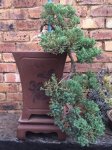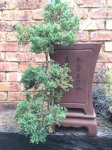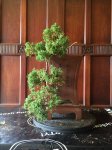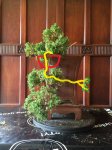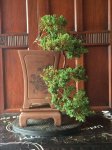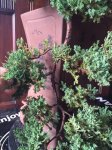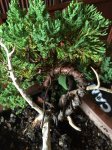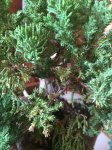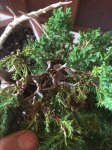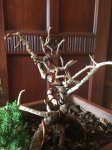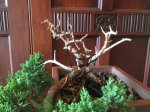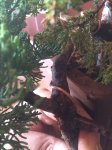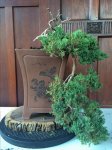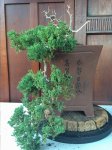Dorian Fourie
Chumono
I have been growing this Juniper procumbens as a cascade for about 9 - 10 years of which most of those years I didn't have a clue what I was doing?
So for a while now I have been looking at the cascade and I have not been happy with the growth on most of the pads running down the cascade. With my limited knowledge over the years, I feel that I have done more harm then good and I am not sure that the pads will be able to be sorted.
This got me thinking on how to rescue the tree and make something from it. So going through the web and looking for inspiration I stumbled across a picture of a literati cascade that I just thought was amazing. Seeing this literati made me think that it would be possible to covered my cascade into a literati cascade.
The base of the trunk already has good movement and will work nicely over the edge of a pot. All growth above this area can be killed off a Jin's created.
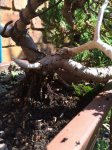

The growth at the bottom will become the "Canopy". As it is the youngest part of the tree, I have hardly ever done any work on it and it should lend itself to being styled correctly for the future.
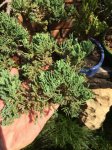
All growth along the trunk can be removed and the trunk line can be wired and bent to make the cascade literati more believable and appealing.

This is the image of the literati that made me think that it was possible. Unfortunately the website did not say who's tree this is so I cannot give credit where due.

Would love to hear your thoughts or suggestions on this.
So for a while now I have been looking at the cascade and I have not been happy with the growth on most of the pads running down the cascade. With my limited knowledge over the years, I feel that I have done more harm then good and I am not sure that the pads will be able to be sorted.
This got me thinking on how to rescue the tree and make something from it. So going through the web and looking for inspiration I stumbled across a picture of a literati cascade that I just thought was amazing. Seeing this literati made me think that it would be possible to covered my cascade into a literati cascade.
The base of the trunk already has good movement and will work nicely over the edge of a pot. All growth above this area can be killed off a Jin's created.


The growth at the bottom will become the "Canopy". As it is the youngest part of the tree, I have hardly ever done any work on it and it should lend itself to being styled correctly for the future.

All growth along the trunk can be removed and the trunk line can be wired and bent to make the cascade literati more believable and appealing.

This is the image of the literati that made me think that it was possible. Unfortunately the website did not say who's tree this is so I cannot give credit where due.

Would love to hear your thoughts or suggestions on this.


